2015 MERCEDES-BENZ SLS AMG GT ROADSTER ESP
[x] Cancel search: ESPPage 265 of 290
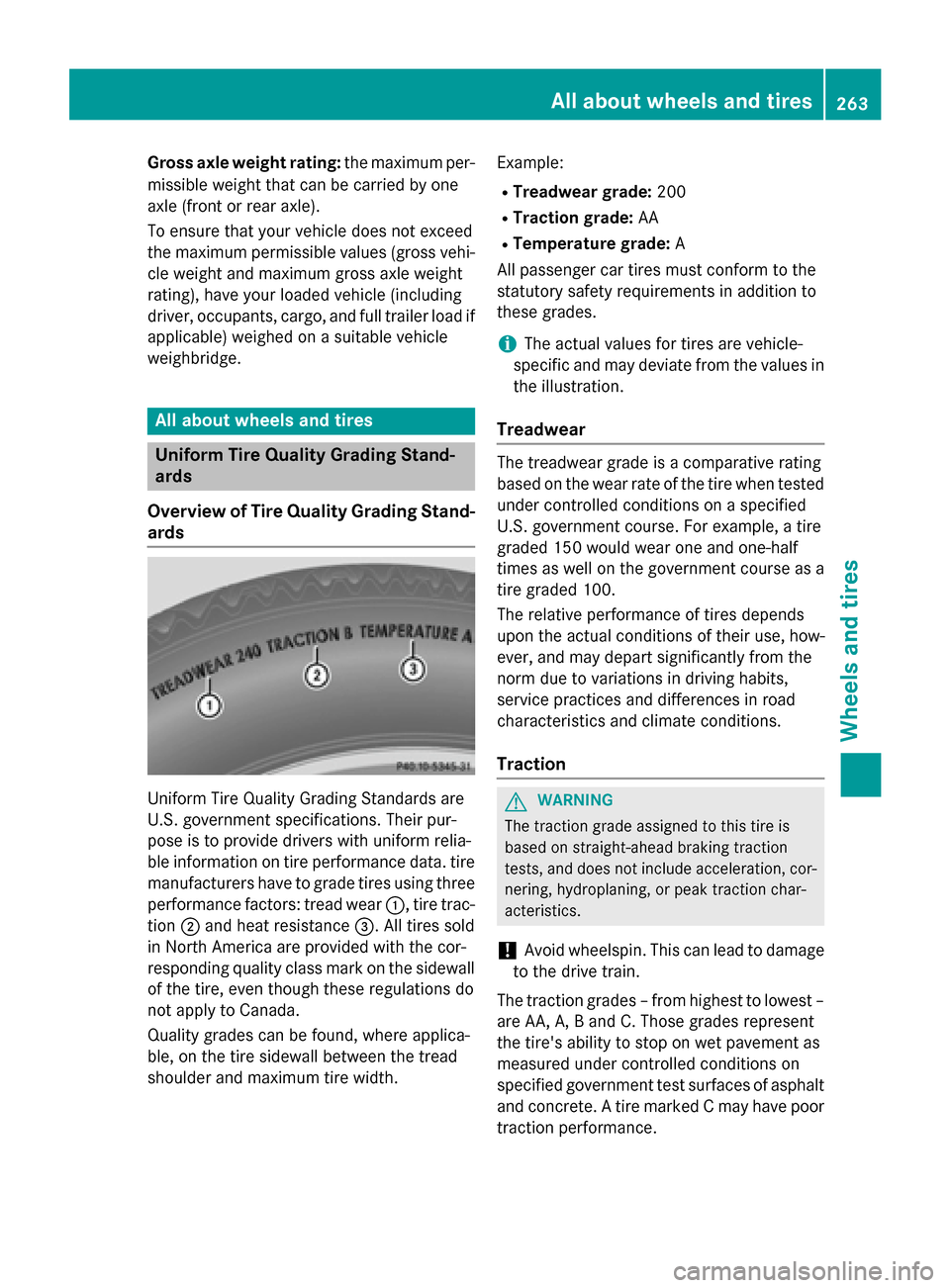
Gross axle weight rating:
the maximumper-
missible weight that can be carried by one
axle (front or rear axle).
To ensure that yourv ehicle does not exceed
the maximu mpermissibl evalues (gross vehi-
cle weight and maximu mgross axle weight
rating), have yourl oaded vehicle (including
driver, occupants, cargo, and full traile rloa dif
applicable) weighed on asuitable vehicle
weighbridge. All about wheels and tires
Uniform Tire Quality Grading Stand-
ards
Overvie wofTire Quality Grading Stand-
ards Uniform Tire Quality Grading Standards are
U.S. government specifications. Theirp ur-
pose is to provid edrivers with uniform relia-
ble information on tire performance data. tire manufacturers have to grade tires using three
performance factors: tread wear 0043,tire trac-
tion 0044and heat resistance 0087.All tires sold
in North America are provided with the cor-
responding quality class mark on the sidewall
of the tire, even though these regulations do
not apply to Canada.
Quality grade scan be found, where applica-
ble, on the tire sidewallb etweenthe tread
shoulder and maximu mtire width. Example:
R Treadwear grade: 200
R Traction grade: AA
R Temperatur egrade: A
All passenger car tires must conform to the
statutory safety requirements in addition to
these grades.
i The actual values for tires are vehicle-
specifi cand may deviate from the values in
the illustration.
Treadwear The treadwear grade is
acomparative rating
basedont he wearrate of the tire when tested
under controlled conditions on aspecified
U.S. government course. For example, atire
grade d150 would wearo ne and one-half
times as wellont he government course as a
tire grade d100.
The relative performance of tires depends
upont he actual conditions of their use, how-
ever, and may depart significantly from the
norm due to variations in driving habits,
service practices and differences in road
characteristics and climate conditions.
Traction G
WARNING
The traction grade assigned to this tire is
basedons traight-ahead braking traction
tests, and does not includ eacceleration, cor-
nering, hydroplaning, or peakt raction char-
acteristics.
! Avoid wheelspin. This can leadtod
amage
to the drive train.
The traction grade s–from highest to lowest –
are AA, A, Band C. Those grade srepresent
the tire's ability to stop on wet pavement as
measured under controlled conditions on
specified government test surfaces of asphalt
and concrete. Atire marked Cmay have poor
traction performance. Alla
bout wheels and tires
263Wheelsand tires Z
Page 266 of 290
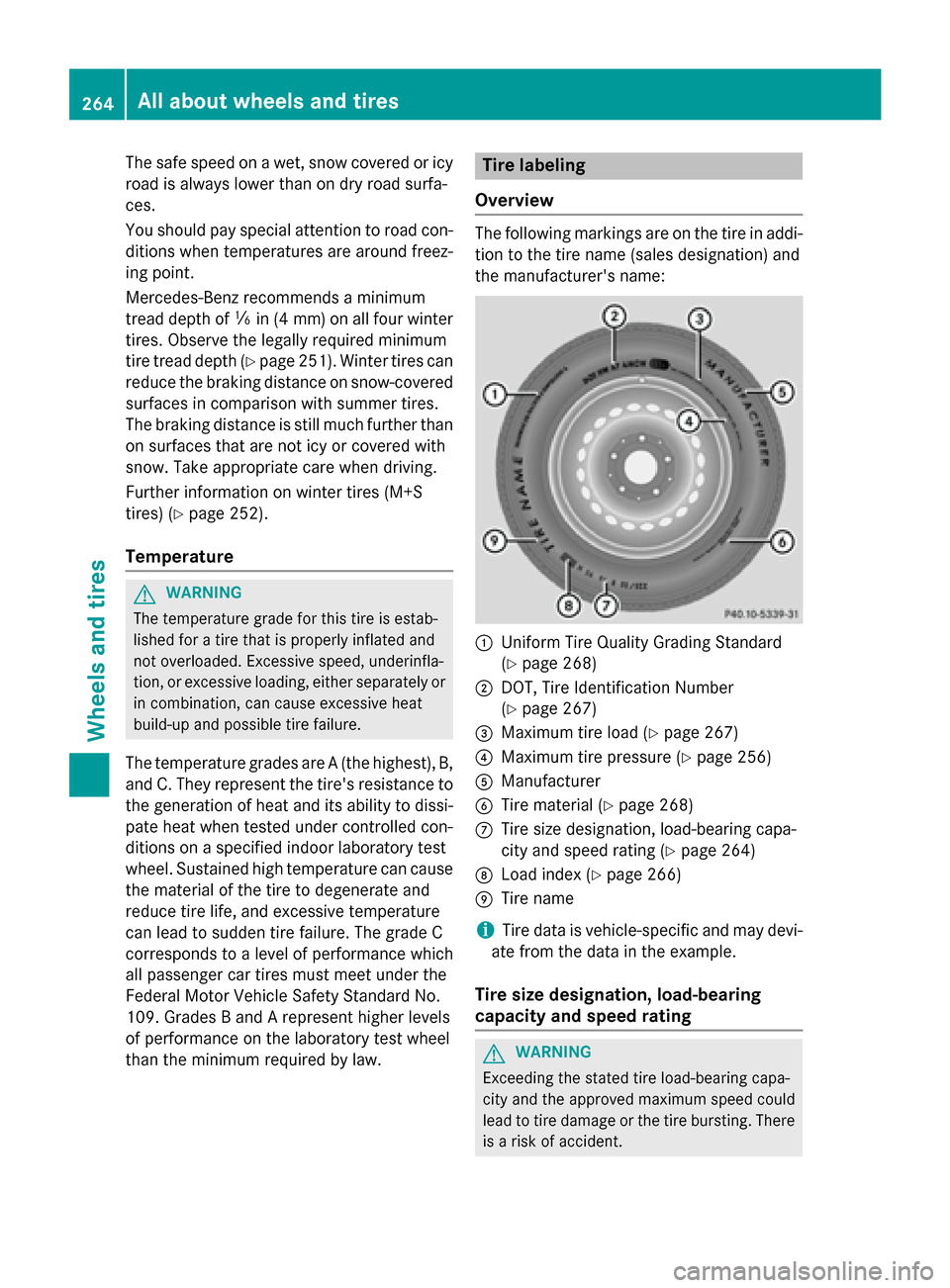
The safe speed on
awet, snow covered or icy
road is alway slower than on dry road surfa-
ces.
You should pay special attention to road con-
ditions when temperatures are around freez-
ing point.
Mercedes-Benz recommends aminimum
tread depth of 00CFin (4 mm )onall four winter
tires. Observe the legally required minimum
tire tread depth (Y page 251). Winter tires can
reduce the braking distanc eonsnow-covered
surfaces in comparison with summer tires.
The braking distanc eisstill much further than
on surfaces that are not icy or covered with
snow. Take appropriate care when driving.
Further information on winter tires (M+S
tires) (Y page 252).
Temperature G
WARNING
The temperature grade for this tire is estab-
lished for atire that is properly inflated and
not overloaded. Excessive speed, underinfla-
tion, or excessiv eloading, either separately or
in combination, can cause excessiv eheat
build-up and possible tire failure.
The temperature grades are A(the highest), B,
and C. They represent the tire's resistanc eto
the generation of heat and its ability to dissi- pate heat when tested under controlled con-
ditions on aspecified indoor laboratory test
wheel. Sustained high temperature can cause
the material of the tire to degenerate and
reduce tire life, and excessiv etemperature
can lead to sudden tire failure. The grade C
corresponds to alevel of performance which
all passenger car tires must meet under the
Federal Motor Vehicle Safety Standard No.
109. Grades BandArepresent higher levels
of performance on the laboratory test wheel
than the minimum required by law. Tire labeling
Overview The following markings are on the tire in addi-
tion to the tire name (sales designation) and
the manufacturer's name: 0043
Uniform Tire Quality Grading Standard
(Ypage 268)
0044 DOT, Tire Identification Number
(Ypage 267)
0087 Maximum tire load (Y page 267)
0085 Maximum tire pressure (Y page 256)
0083 Manufacturer
0084 Tire material (Y page 268)
006B Tire size designation, load-bearing capa-
city and speed rating (Y page 264)
006C Load index (Y page 266)
006D Tire name
i Tire data is vehicle-specific and may devi-
ate from the data in the example.
Tire size designation, load-bearing
capacity and speed rating G
WARNING
Exceeding the stated tire load-bearing capa-
city and the approved maximum speed could
lead to tire damage or the tire bursting. There is ar isk of accident. 264
All about wheelsa
nd tiresWheels and tires
Page 276 of 290
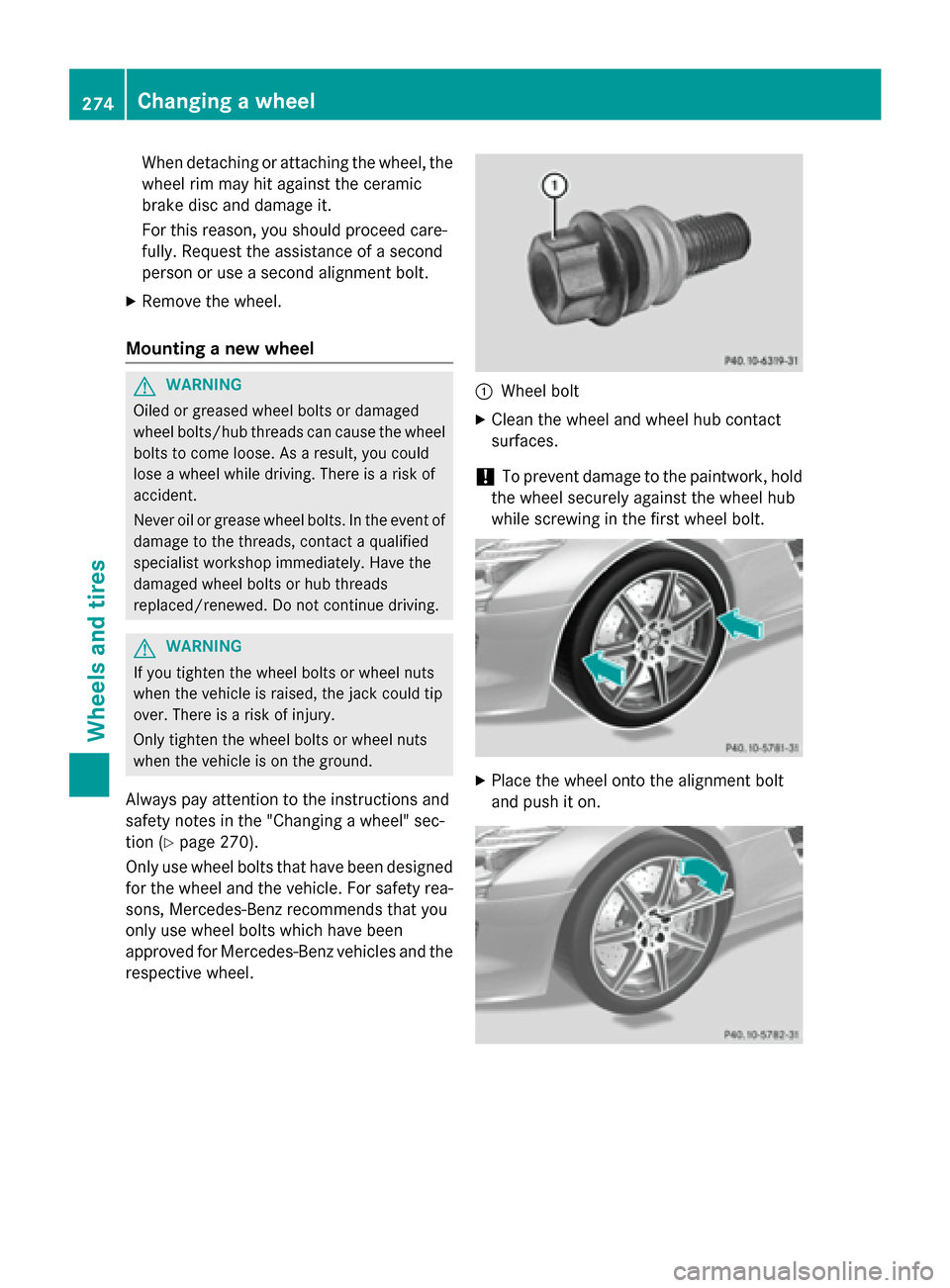
When detachin
gorattaching the wheel, the
wheel rim may hit against the ceramic
brake disc and damage it.
For this reason, you should proceed care-
fully. Request the assistanc eofasecond
person or use asecon dalignment bolt.
X Remove the wheel.
Mounting anew wheel G
WARNING
Oiled or greased wheel bolts or damaged
wheel bolts/hub threads can cause the wheel bolts to come loose. As aresult, you could
lose awheel while driving. There is arisk of
accident.
Never oil or grease wheel bolts. In the event of damage to the threads, contact aqualified
specialist workshop immediately. Have the
damaged wheel bolts or hub threads
replaced/renewed. Do not continue driving. G
WARNING
If you tighten the wheel bolts or wheel nuts
when the vehicle is raised, the jack could tip
over. There is arisk of injury.
Only tighten the wheel bolts or wheel nuts
when the vehicle is on the ground.
Always pay attention to the instructions and
safety notes in the "Changing awheel" sec-
tion (Y page 270).
Only use wheel bolts that have been designed for the wheel and the vehicle. For safety rea-
sons, Mercedes-Benz recommends that you
only use wheel bolts which have been
approved for Mercedes-Benz vehicles and the
respective wheel. 0043
Wheel bolt
X Clean the wheel and wheel hub contact
surfaces.
! To preven
tdamage to the paintwork ,hold
the wheel securely against the wheel hub
while screwin ginthe first wheel bolt. X
Place the wheel ontot he alignment bolt
and push it on. 274
Changing
awheelWheels and tires
Page 277 of 290
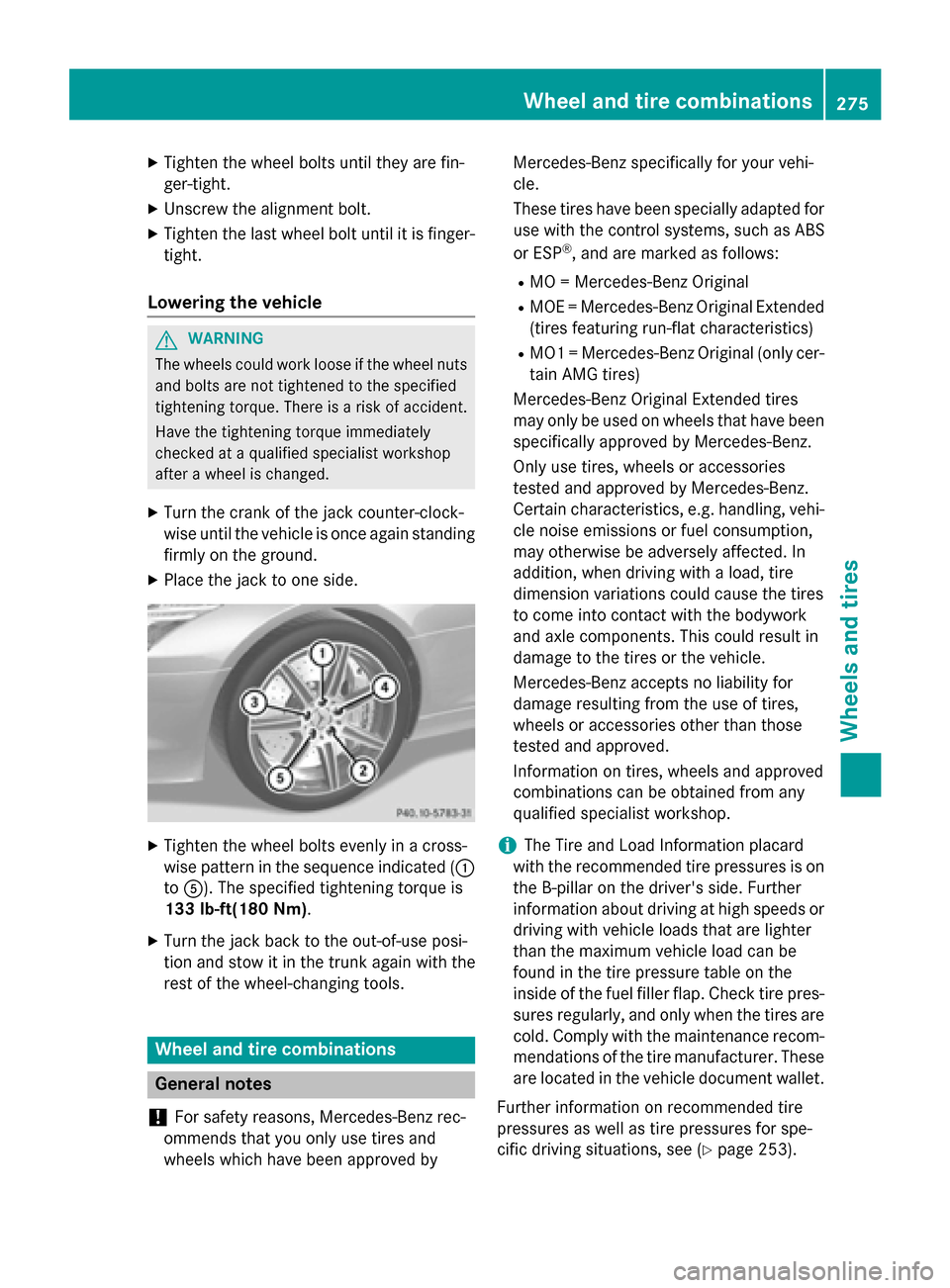
X
Tighten the wheel bolts until they are fin-
ger-tight.
X Unscrew the alignment bolt.
X Tighten the last wheel bolt until it is finger-
tight.
Lowering the vehicle G
WARNING
The wheels could work loose if the wheel nuts and bolts are not tightened to the specified
tightening torque. There is arisk of accident.
Have the tightening torque immediately
checked at aqualified specialist workshop
after awheel is changed.
X Turn the crank of the jack counter-clock-
wise until the vehicle is once again standing
firmly on the ground.
X Place the jack to one side. X
Tighten the wheel bolts evenly in across-
wise pattern in the sequence indicated ( 0043
to 0083). The specified tightening torque is
133 lb-ft(180 Nm).
X Turn the jack back to the out-of-use posi-
tion and stow it in the trunk again with the
rest of the wheel-changin gtools. Wheel and tire combinations
General notes
! For safety reasons, Mercedes-Benz rec-
ommends that you only use tires and
wheels which have been approved by Mercedes-Benz specifically for your vehi-
cle.
These tires have been specially adapted for
use with the control systems, such as ABS
or ESP ®
,a nd are marked as follows:
R MO =Mercedes-Benz Original
R MOE =Mercedes-Benz Original Extended
(tires featuring run-flat characteristics)
R MO1 =Mercedes-Benz Original (only cer-
tain AMG tires)
Mercedes-Benz Original Extended tires
may only be used on wheels that have been
specifically approved by Mercedes-Benz.
Only use tires, wheels or accessories
tested and approved by Mercedes-Benz.
Certain characteristics, e.g. handling, vehi-
cle noise emissions or fuel consumption,
may otherwise be adversely affected. In
addition, when driving with aload, tire
dimension variations could cause the tires
to come into contact with the bodywork
and axle components. This could result in
damage to the tires or the vehicle.
Mercedes-Benz accepts no liability for
damage resulting from the use of tires,
wheels or accessories other than those
tested and approved.
Information on tires, wheels and approved
combinations can be obtained from any
qualified specialist workshop.
i The Tire and Load Information placard
with the recommended tire pressures is on the B-pillar on the driver's side. Further
information about driving at high speeds or driving with vehicle loads that are lighter
than the maximum vehicle load can be
found in the tire pressure table on the
inside of the fuel filler flap. Check tire pres- sures regularly, and only when the tires arecold. Comply with the maintenance recom-
mendation softhe tire manufacturer. These
are located in the vehicle document wallet.
Further information on recommended tire
pressures as well as tire pressures for spe-
cific driving situations, see (Y page 253). Wheel and tirec
ombinations
275Wheels and tires Z
Page 283 of 290
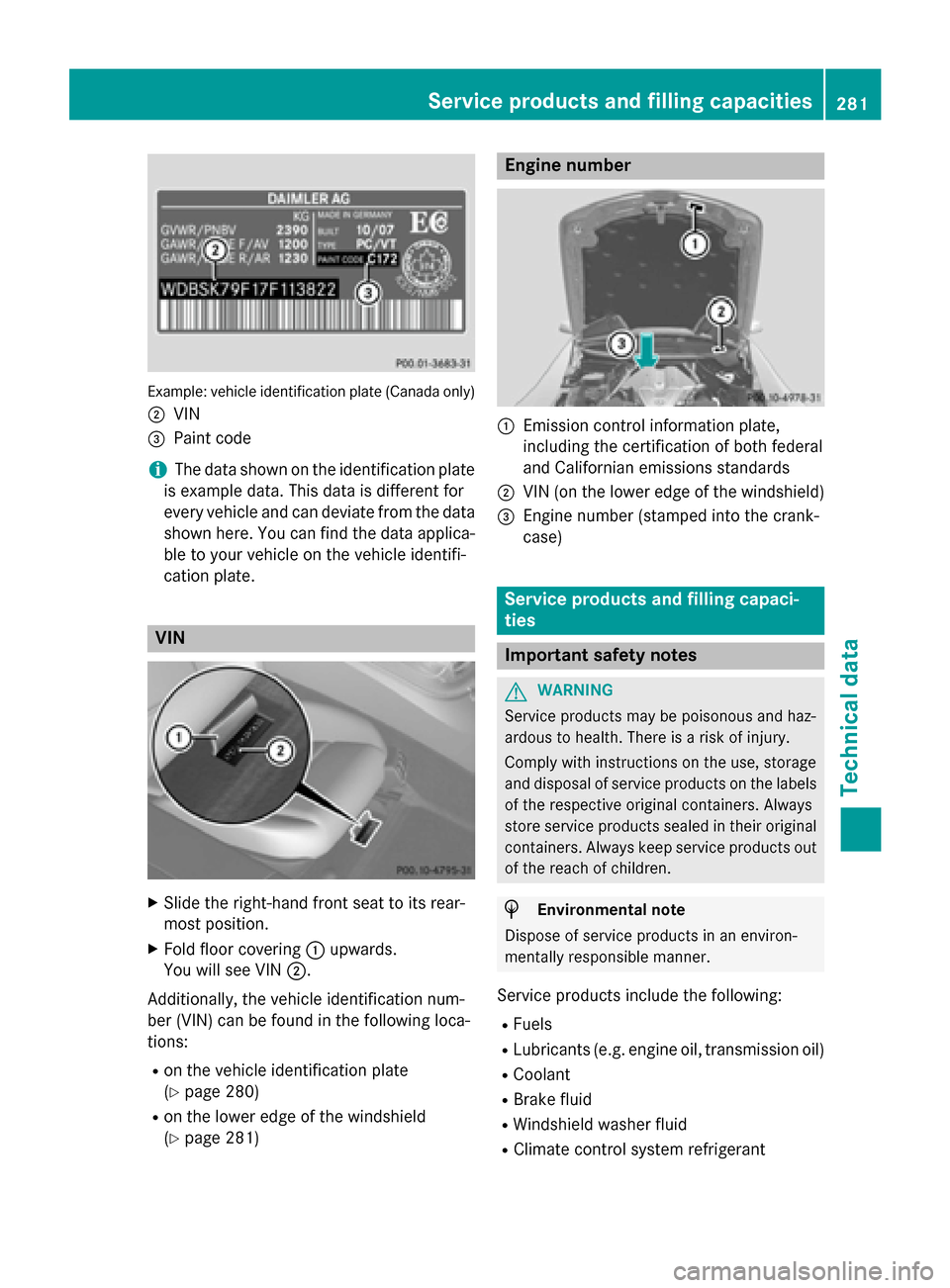
Example: vehicl
eide ntification plate (Canada only)
0044 VIN
0087 Paint code
i The data shown on the identificatio
nplate
is exampl edata. Thi sdataisd ifferent for
every vehicl eand can deviate from the data
shown here. Yo ucan find the data applica-
bl etoy ourv ehicl eont he vehicl eide ntifi-
cation plate. VIN
X
Slide the right-hand front sea ttoits rear-
mos tposit ion.
X Fol dfloor covering 0043upwards.
Yo uw ills ee VIN 0044.
Additionally, the vehicl eide ntificatio nnum-
be r(VIN) can be found in the following loca-
tions:
R on the vehicl eide ntificatio nplate
(Y page 280)
R on the lowe redgeoft he windshield
(Y page 281) Engine number
0043
Emission contro linformatio nplate,
including the certificatio nofbothf ederal
and Californian emissions standards
0044 VIN (o nthe lowe redgeoft he windshield)
0087 Engine numbe r(stamped into the crank-
case) Servic
eproducts and filling capaci-
ties Important safety notes
G
WARNING
Service products ma ybepoisonousand haz-
ardous to health .There is ariskofi njury.
Compl ywithi nstructions on the use, storage
and disposa lofservic eproducts on the labels
of the respective original containers. Always
stor eservic eproducts seale dintheiroriginal
containers. Alway skeeps ervic eproducts out
of the reach of children. H
Environmental note
Dispose of servic eproducts in an environ-
mentall yresponsibl emanner.
Service products includ ethe following:
R Fuels
R Lubricants (e.g. engine oil, transmission oil)
R Coolant
R Brake fluid
R Windshield washe rfluid
R Climate contro lsystem refrigerant Servic
eproducts and filling capacities
281Technicaldata Z
Page 288 of 290
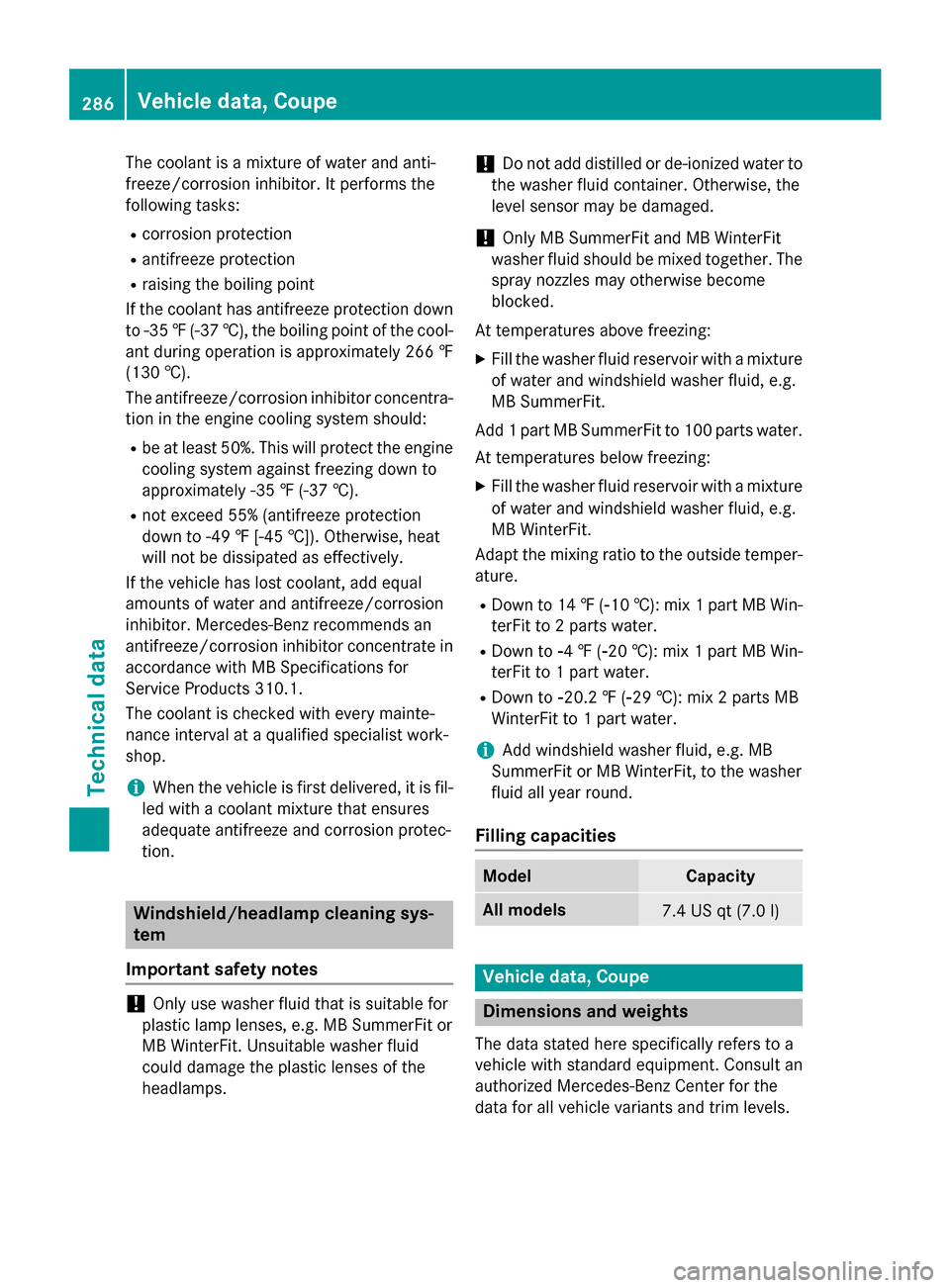
The coolant is
amixture of water and anti-
freeze/corrosion inhibitor. It performs the
following tasks:
R corrosion protection
R antifreeze protection
R raising the boiling point
If the coolant has antifreeze protection down to -35 ‡(-37 †), the boiling point of the cool-
ant during operatio nisa pproximately 266 ‡
(13 0† ).
Th ea ntifreeze/corrosion inhibito rconcentra-
tio nint he engine cooling syste mshould:
R be at leas t50% .Thisw illp rotect the engine
cooling syste magain st freezing down to
approximately -35‡(-37† ).
R no te xceed 55% (antifreeze protection
down to -49‡[-45† ]).O therwise, heat
will no tbed issipated as effectively.
If the vehicl ehaslost coolant, ad dequal
amounts of water and antifreeze/corrosion
inhibitor. Mercedes-Benz recommend san
antifreeze/corrosio ninhibito rconcentrate in
accordanc ewithMBS pecifications for
Service Products 310.1.
Th ec oolant is checked with every mainte-
nanc einterva lataq ualified specialis twork-
shop.
i When the vehicl
eisfirst delivered ,itisfil-
le dw ithac oolant mixtur ethate nsures
adequate antifreeze and corrosio nprotec-
tion. Windshield/headlamp cleaning sys-
tem
Important safety notes !
Onl
yusewashe rfluid thatiss uitabl efor
plastic lamp lenses, e.g .MBSummerFit or
MB WinterFit. Unsuitabl ewashe rfluid
could damage the plastic lense softhe
headlamps. !
Do not ad
ddistilled or de-ionize dwater to
the washe rfluid container. Otherwise, the
level senso rmaybe damaged.
! Onl
yMBS ummerFit and MB WinterFit
washe rfluid shoul dbem ixed together. The
spra ynozzles ma yotherwis ebecome
blocked.
At temperatures above freezing: X Fil lthe washe rfluid reservoi rwitham ixture
of water and windshiel dwashe rfluid, e.g.
MB SummerFit.
Add 1partMBS ummerFit to 100 parts water.
At temperatures belo wfreezing:
X Fil lthe washe rfluid reservoi rwitham ixture
of water and windshiel dwashe rfluid, e.g.
MB WinterFit.
Adapt the mixing ratio to the outside temper-
ature.
R Dow nto1 4‡( 00F810 †): mix 1partMBW in-
terFit to 2parts water.
R Down to 00F84‡(00F820 †): mix 1partMBW in-
terFit to 1partw ater.
R Down to 00F820.2‡(00F829 †): mix 2parts MB
WinterFi tto1partw ater.
i Add windshield washer fluid, e.g. MB
SummerFi torMBWinterFit, to the washer
fluid ally earround.
Filling capacities Model Capacity
Allm
odels 7.4 US qt (7.0
l) Vehicl
edata, Coupe Dimension
sand weights
The data stated her especifically refers to a
vehicl ewiths tandard equipment. Consult an
authorize dMercedes-Benz Center for the
data for al lvehicl evariants and trim levels. 286
Vehicl
edata, CoupeTechnica ldata